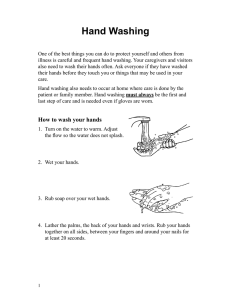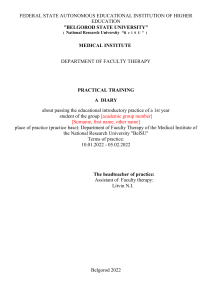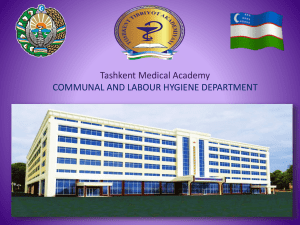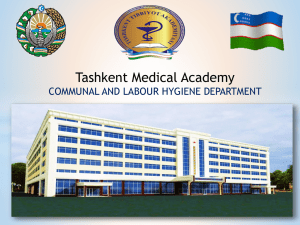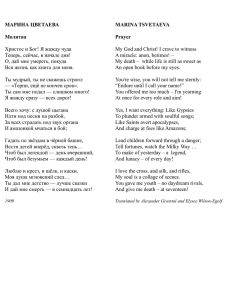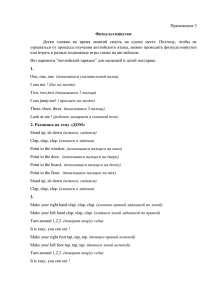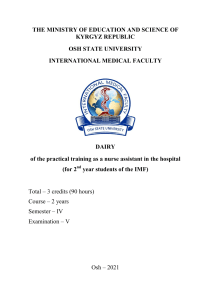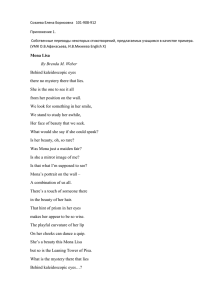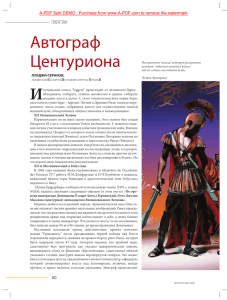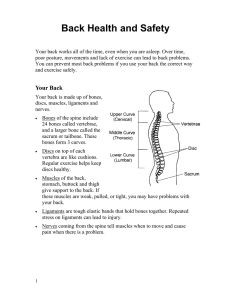practical lesson № 1
advertisement
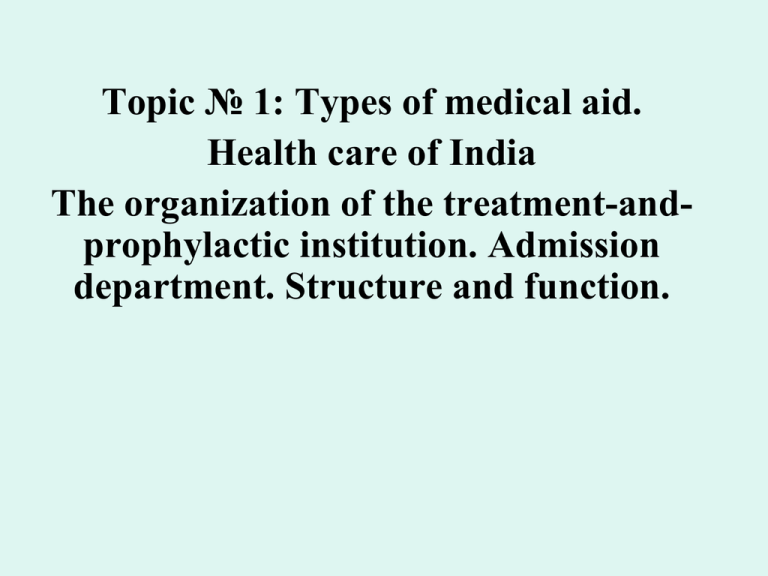
Topic № 1: Types of medical aid. Health care of India The organization of the treatment-andprophylactic institution. Admission department. Structure and function. TYPES (levels) OF MEDICAL AID 1. First aid A) self-help B) the mutual B) help paramedics (Police, fireman, stewardess, etc.) 2. pre-medical care (pre-doctor care). Рre-medical care provides the nursing personnel: doctor’s assistant or nurse. 3. The first medical aid. Simple medical manipulations, prophylactic and sanitary-andhygienic measure. 4. Qualified medical aid. Сomplex medical manipulation surgical and therapeutic profile are performed by a physician, a surgeon, pediatrist, etc. 5. Specialized medical aid. This is aid of narrowly focused specialist: cardiologist, arrhythmologist, endocrinologist, etc., in specialized treatment institutions. Health care of India The system of the delivery of health care to the population in India is represented by two types of medical institutions: it is public and private hospitals. There are also private clinics. The public (state) hospital provides inexpensive medical treatment, and sometimes free. In private hospitals, all fully paid for by the patient. First aid in extreme situation is provided in public hospitals. Later, the patient chooses the type of medical assistance. Doctors in India are responsible for their decisions and medical manipulations in accordance with the law. Complaints will be reviewed by the people's court. An important problem of the Indian state is a significant level of poverty in the country and the inaccessibility of quality health care for all segments of the population. India spends only 1% of national income on health care. Other developing countries spend 3%. But economy and health care is growing at a rapid pace lately. Health сare India demonstrates success in different directions. Indian doctors performs surgical operations of varying complexity at a high level. Basic surgical directions - cardiac surgery, оncology, bone marrow transplant, the transplant kidney. The efficiency of treatment of stenocardia in India is 99%. In the United States of 97%. In India is rapidly developing the medical insurance. Now 100% of India's population have the health insurance and can get free the medical care. 5.Производство медицинского оборудования быстро развивается. В настоящее время 35% медицинского оборудования делают в стране. Совместные предприятия создаются для производства медицинского оборудования. Израильская компания «Elbit Medical Imaging» намерена осуществить в Индии ряд проектов: • строительство больницы и центра биотехнологических исследований в Калькутте. • строительство в Индии научно– производственного центра по исследованию стволовых клеток. • проект по изучению возможности уничтожения фиброзных опухолей при помощи ультразвука без хирургического вмешательства. • открытие медицинского колледжа и школы медсестер. Сегодня Индия является лидером в производстве медицинских препаратов (на втором месте находится Китай, на третьем Бразилия). Production of medical equipment is evolving rapidly. Now 35% of medical equipment are doing in the country. Joint ventures are created for the production of medical equipment, such as «Siemens», «GE», «Philips Medical Systems», «Toshiba», «Hitachi», «Boston Scientific» and other. The Israeli company «Elbit Medical Imaging» plans to make in India the several projects together with Indian experts: • the construction of the hospital and the centre for biotechnology research in Kolkata; • the construction scientific-production centre for stem cell research in India; • the study of the treatment of fibrous tumors without surgery (using ultrasound); • the opening of the medical College and the school of nursing. Today, India is a leader in the manufacture of a medical preparations (in second place is China, the third - Brazil). Main directions of the delivery of health care in Russia treatment-and-prophylactic. Types of the treatment-and-prophylactic institution: Ambulatory (out-patient clinics) and Hospitals (in-patient clinics) TYPES OF MEDICAL INSTITUTIONS 1.Policlinic. Patients served by the policlinic and at home (without hospitalization), located in the city. 2.Ambulatory. Patients served in the ambulatory and at home (without hospitalization), located in a small town. 3.Medico-sanitary department. Task - service workers of industrial enterprises, consists of a policlinic, hospital, health center, preventorium. 4. Dispensary - specialized institutions in which receive treatment patients with certain pathology (tuberculosis, skin and venereal diseases, cancer etc.) 5.Station of Ambulance - provides emergency specialized medical aid around the clock. 6. Women's Consultation – carry out control and treatment of women with gynecological diseases, and prenatal service. 7. Hospital – carry out dynamic control and treatment of patients around the clock. 8. Clinic - the hospital, which is composed of the Chair of Medical school. 9. Military hospital - a hospital for sick soldiers and disabled veterans. 10. Sanatorium - a hospital in the resort zone, where carry out therapy by natural and physical methods. The structure of the hospital: • • • • • • • admission department; inpatient departments diagnostic department; pharmaceutical department. kitchen laundry administration rooms. Types of hospitalization: • planned hospitalization. The patient comes to the hospital in the direction of a doctor from the policlinic or comes to the hospital by yourself. • emergency hospitalization. The patient is admitted to a hospital in an emergency (acute illness, trauma, injury and other) • transfer from another medical hospital Admission department This department, where provide registration, the initial examination of patients, sanitary and hygienic processing, providing qualified emergency aid. Functions of the admission department: 1. Reception and registration of patients. 2. The medical examination of the patient. 3. Emergency medical aid. 4. Оfficial registration of medical papers. 5. Determination department for hospitalization. 6. Sanitary and hygienic processing of patients. 7. Transportation of patients. The structure of admissions department: 1. The waiting room - a room for patients and relatives, which should be plenty of chairs, an information board. 2. Registry - special сabinet where is executed medical records (case history). 3. Examination rooms. 4. Sanitary inspection room is consisting of several rooms: a room for undressing patients , bathroom or shower room, dressing room. 5. Diagnostic room 6. Isolator 7. The treatment room . 8. Operating room (bandaging room) 9. X-ray room 10. laboratory 11. Room of duty doctor 12. Room of head of department 13. Toilet room (WC) 14. Warehouse for the storage patient’s clothes The principle of operation of the admissions Department Принцип работы приемного отделения 1) 2) 3) 4) registration of patients medical examination sanitary and hygienic processing transportation of patients REGISTRATION OF PATIENTS • the nurse records the patient data in medical documentation, • the nurse measures the body temperature • invites of the doctor of admissions department; MEDICAL DOCUMENTS of admission department 1. 2. 3. 4. 5. 6. Journal of registration of patients and refusal of hospitalization Medical hospital card (medical history) Journal of examination for pediculosis Journal of notifiable infectious diseases Emergency notification in sanitation and epidemiological institutions Journal of telephone messages, etc. MEDICAL EXAMINATION • The physician examines the patient in the exam room • The doctor determines the indications for hospitalization in hospital. • The doctor prescribes the minimum examination in accordance with the disease. • The physician provides first aid if the patient's condition is severe (seriously ill). • The patient is directly hospitalized in the intensive care unit, if the patient's condition is critical. • The doctor determines the volume of sanitization. SANITARY AND HYGIENIC PROCESSING OF PATIENTS Types of sanitary and hygienic processing: • complete processing • partial processing. • • • • The algorithm complete sanitary and hygienic processing: examination of the hair and skin (detection pediculosis); grooming of nails and hair (if needed); shaving (if needed); take a shower or hygienic bath. Partial sanitary and hygienic processing is partial wash and wiping the skin. Partial processing is performed if the patient in critical condition. 1. 2. 3. The structure of sanitary inspection room a room for undressing patients where patients undress and are inspected. Shower or bathroom, where patients take a shower or bath. Dressing room where patients dress in clean clothes. Clothes of patients is delivered in a warehouse. If the patient revealed an infection, his clothes is delivered in the disinfection chamber. The patient is placed in isolator or hospitalized to the infectious diseases hospital. Examination of the skin and hair of the patient is carried out with the purpose of case detection pediculosis. Pediculosis - a specific parasitism of lice on human, which feed on its blood. Louse vectors of typhus and relapsing fever and other rickettsial diseases. Types of lice: A) Head louse B) Body louse (louse on clothing) С) pubic louse (epidemiological do not matter) ОБРАБОТКА ВОЛОСИСТОЙ ЧАСТИ ГОЛОВЫ ПРИ ПЕДИКУЛЁЗЕ Оснащение: 1. Спецодежда для медсестры( дополнительный халат, косынка, медицинские перчатки, клеёнчатый фартук. 2. Педикулицид( «Ниттифор», «Медифокс» и др.) 3. Столовый уксус( 6 % раствор уксусной кислоты) 4. Расчёска 5. Клеёнка 6. Косынка 7. Шампунь 8. Полотенце 9. Мешок для грязного белья 10. Контейнер с дезинфицирующим средством Processing hair of the head with pediculosis Equipment: 1. Protective clothes for nurses (medical gown, additional medical gown, medical cap, oilcloth apron, gloves) 2. The solution against lice. For example Pedikulitsid ("Nittifor" "Medifoks", etc.) 3. Vinegar (6% acetic acid solution) 4. Comb 5. Oilcloth 6. Kerchief 7. Shampoo 8. Towel 9. Laundry bag 10. A container with a disinfectant solution 20/АЛГОРИТМ ДЕЙСТВИЯ : 1. Надеть спецодежду. 2. Расстелить клеёнку, усадить пациента на стул или кушетку. 3. Нанести препарат на волосы пациента. 4. Повязать на голову косынку и выдержать необходимое время, согласно методическим указаниям на данный препарат. 5. Смыть препарат тёплой водой с шампунем. 6. Ополоснуть волосы 6% тёплым раствором столового уксуса 7. Тщательно вычесать вши и гниды частой расчёской. 8. Произвести дезинфекцию предметов ухода и спец одежды. 9. Внести запись в медицинскую карту пациента( на титульном листе обозначение « P») 10. Обработать помещение. Algorithm of actions: 1. Wear protective clothes. 2 . Spread out oilcloth, seat the patient on a chair or couch. 3 . Apply the medication to the patient's hair . 4 . Wear a kerchief on head and sustain the necessary time, according to methodical instructions on the medication. 5 . Wash off medication with warm water and with shampoo. 6. Rinse hair with warm water and 6% vinegar. 7. Carefully comb out lice and nits louse with comb. 8. Disinfect object of care and protective clothes. 9. Make an entry in the patient's medical document. Marking «P» on the title page of Medical hospital card (medical history) 10 . Process the room. 21/ТРАНСПОРТИРОВКА БОЛЬНЫХ 1. На носилках 2. На кресле-каталке 3. Пешком (в сопровождении медперсонала – санитарки и , или медсестры) Необходимо учитывать состояние пациента. TRANSPORTATION OF PATIENTS The doctor determines the method of transportation of the patient in the hospital: 1. On a stretcher (gurney) 2. A wheelchair 3. On foot (accompanied by medical personnel - nurse) Necessary take into account the patient's condition. 22/Транспортировка пациента на каталке: 1. Поставить каталку перпендикулярно кушетке(кровати), головной конец каталки к ножному концу кушетки. 2. Поднять пациента, повернуться на 90° в сторону каталки. 3. Уложить пациента на каталку, укрыть его. 4. Везти по отделению головой вперёд, чтобы оценивать возможные изменения состояния пациента. 5. Приставить в палате головной конец каталки к ножному концу кровати. 6. Поднять пациента, повернуться на 90° ,положить его на кровать. 7. Обработать каталку. 8. Сбросить ветошь и перчатки в дезинфектант. Transportation a patient on a stretcher: 1. Wear gloves. 2. Put the stretcher perpendicularly couch (bed), put the head end of stretcher to the foot end of the couch (bed). 3. Raise the patient, turn in the direction of stretcher on 90 ° . 4. Place the patient on a stretcher, cover him. 5. Carry the stretcher (roll the gurney) in the department by head forward to evaluate possible changes patient’s condition. 6. In the ward put the head end of the stretcher to the foot end of the bed. 7. Raise the patient, turn on 90 °, put him on the bed. 7. Process the stretcher. 8. Put rags and gloves in disinfectant. Способы перекладывания пациента: При участи трёх медработников отделения: • Первый подводит руки под голову и лопатки пациента; • Второй подводит руки под таз и верхнюю часть бёдер; • Третий подводит руки под середину бёдер и голеней. При участии двух медработников отделения: • Первый подводит руки под голову и туловище пациента; • Второй подводит руки под таз и середину бёдер. Methods for shifting the patient: With the assistance of the three medical personnel of department: • The first nurse supports the head and sсapula of patient; • The second nurse supports the pelvis and the upper thighs; • The third nurse supports the center of the thighs and lower legs. With the assistance of two medical personnel of department: • The first nurse supports the patient's head and trunk; • The second nurse supports the pelvis and the center of the thighs. 24/Транспортировка пациента на кресле-каталке: 1. Обеспечить безопасную транспортировку зафиксировать тормоз. 2. Поддерживая пациента, усадить его на креслокаталку. 3. Поместить руки пациента на подлокотники. 4. Ноги пациента поставить на подставку для ног. 5. Снять каталку с тормоза и транспортировать пациента в отделение. 6. Обработать кресло. 7. Поместить ветошь и перчатки в дезраствор. Transportation the patient on a wheelchair: 1. Ensure safe transportation - fix brake. 2. Supporting the patient sit him to a wheelchair. 3. Put patient’s hands on the armrest. 4. The patient's legs put on a footrest. 5. Remove the wheelchair with brakes and transport the patient to the department. 6. Process wheelchair. 7. Put rags and gloves in disinfectant solution.
